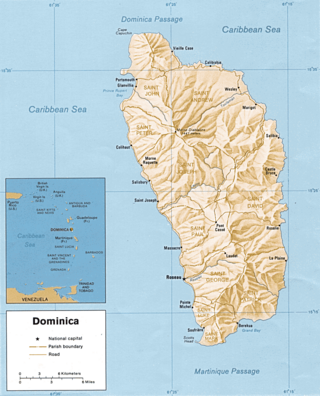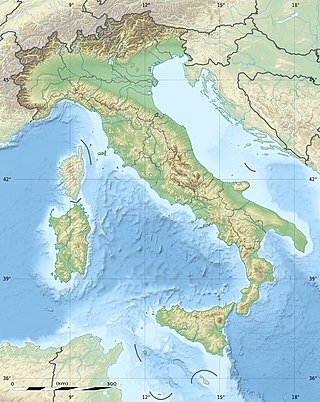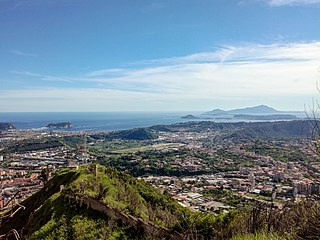
Dominica is an island in the Caribbean Sea, located about halfway between the French islands of Guadeloupe and Martinique. Its coordinates are 15 25 N, 61 20 W. It is known as "The Nature Island of the Caribbean" due to its spectacular, lush, and varied flora and fauna, which is protected by an extensive natural park system. It is the fourth largest island in the Eastern Caribbean with a population of people mainly of African descent.

The geography of Italy includes the description of all the physical geographical elements of Italy. Italy, whose territory largely coincides with the homonymous geographical region, is located in southern Europe and comprises the long, boot-shaped Italian Peninsula crossed by the Apennines, the southern side of Alps, the large plain of the Po Valley and some islands including Sicily and Sardinia. Italy is part of the Northern Hemisphere. Two of the Pelagie Islands are located on the African continent.

Japan is an archipelagic country comprising a stratovolcanic archipelago over 3,000 km (1,900 mi) along the Pacific coast of East Asia. It consists of 14,125 islands. The four main islands are Hokkaido, Honshu, Kyushu, and Shikoku. The other 14,120 islands are classified as "remote islands" by the Japanese government. The Ryukyu Islands and Nanpō Islands are south and east of the main islands.

The Caucasus Mountains is a mountain range at the intersection of Asia and Europe. Stretching between the Black Sea and the Caspian Sea, they are surrounded by the Caucasus region and are home to Mount Elbrus, the highest peak in Europe at 5,642 metres (18,510 ft) above sea level.

Ischia is a volcanic island in the Tyrrhenian Sea. It lies at the northern end of the Gulf of Naples, about 30 kilometres from the city of Naples. It is the largest of the Phlegrean Islands. Although inhabited since the Bronze Age, as a Greek emporium it was founded in the 8th or 9th century BCE, and known as Πιθηκοῦσαι, Pithekoūsai.

In geology and physical geography, a plateau, also called a high plain or a tableland, is an area of a highland consisting of flat terrain that is raised sharply above the surrounding area on at least one side. Often one or more sides have deep hills or escarpments. Plateaus can be formed by a number of processes, including upwelling of volcanic magma, extrusion of lava, and erosion by water and glaciers. Plateaus are classified according to their surrounding environment as intermontane, piedmont, or continental. A few plateaus may have a small flat top while others have wider ones.

The Phlegraean Fields is a large caldera volcano west of Naples, Italy. It is part of the Campanian volcanic arc, which includes Mount Vesuvius, about 9 km east of Naples. The Phlegraean Fields is monitored by the Vesuvius Observatory. It was declared a regional park in 2003.

The Gulf of Naples, also called the Bay of Naples, is a roughly 15-kilometer-wide (9.3 mi) gulf located along the south-western coast of Italy. It opens to the west into the Mediterranean Sea. It is bordered on the north by the cities of Naples and Pozzuoli, on the east by Mount Vesuvius, and on the south by the Sorrento Peninsula and the main town of the peninsula, Sorrento. The Peninsula separates the Gulf of Naples from the Gulf of Salerno, which includes the Amalfi Coast.

Graham Island or Isola Ferdinandea was an island in the Mediterranean Sea near Sicily that has, on more than one occasion, risen above the surface of the Mediterranean via volcanic action and soon thereafter been washed away. Since 300 BC this cycle of events has occurred four times. The island was part of the submarine volcano Empedocles, 30 km (19 mi) south of Sicily, which is one of a number of underwater volcanoes known as the Campi Flegrei del Mar di Sicilia.

Eldey is a small, uninhabited island about 13 kilometres off the coast of the Reykjanes Peninsula in southwest Iceland. Located west-southwest of Reykjavík, the island of Eldey covers an area of about 3 hectares, and rises to a height of 77 metres (253 ft). Its sheer cliffs are home to large numbers of birds, including one of the largest northern gannet colonies in the world, with around 16,000 pairs. This colony can now be watched live via two webcams that are located on top of the island.

Geologically, a volcanic island is an island of volcanic origin. The term high island can be used to distinguish such islands from low islands, which are formed from sedimentation or the uplifting of coral reefs.

The Danakil Desert is a desert in northeast Ethiopia, southern Eritrea, and northwestern Djibouti. Situated in the Afar Triangle, it stretches across 136,956 square kilometres (52,879 sq mi) of arid terrain. It is inhabited by a few Afar, who engage in salt mining. The area is known for its volcanoes and extreme heat, with daytime temperatures surpassing 50 °C (122 °F). Less than 25 mm (1 in) of rainfall occurs each year. The Danakil Desert is one of the lowest and hottest places on Earth.
Citara is a beach located in Forio d'Ischia, in the Ischia island of Italy, near Punta Imperatore and the village of Panza. Its name comes from Romans who consecrated the site to Venus Citarea, whose statue made of white marble was found in the area. An old legend has it that the rocks, which can be seen from the beach, were in origin sailors transformed into stones as a punishment for passing through. The reference is from Odysseus, in which it is told that “Feaci” provided Ulysses with a boat to get home, so the goddess Venus punished them for helping him. On Citara Beach the Poseidon Thermal Garden is provided with a series of sea and thermal water swimming pools. It is known for its sun catching position and limpid sea. Spring water gushes into the sea.

Rishiri Island is a volcanic island in the Sea of Japan off the coast of Hokkaido, Japan. Administratively the island is part of Hokkaido Prefecture, and is home to two towns, Rishiri and Rishirifuji. The island is formed by the cone-shaped extinct volcanic peak of Mount Rishiri. Along with Rebun Island and the coastal area of the Sarobetsu Plain, Rishiri forms the Rishiri-Rebun-Sarobetsu National Park. The main industries of Rishiri are tourism and fishing. The island has a population of 5,102 residents.

Mount Scenery is a dormant volcano in the Caribbean Netherlands. Its lava dome forms the summit of the Saba island stratovolcano. At an elevation of 870 m (2,854 ft), it is the highest point in both the Kingdom of the Netherlands, and, since the dissolution of the Netherlands Antilles on 10 October 2010, the highest point in the Netherlands proper.

The Phlegraean Islands are an archipelago in the Gulf of Naples and the Campania region of southern Italy.

The Cameroon line is a 1,600 km (1,000 mi) long chain of volcanoes that includes islands in the Gulf of Guinea and mountains on the African mainland, from Mount Cameroon on the coast towards Lake Chad on the northeast. They form a natural border between eastern Nigeria and the West Region of Cameroon. The islands, which span the equator, have tropical climates and are home to many unique plant and bird species. The mainland mountain regions are much cooler than the surrounding lowlands, and also contain unique and ecologically important environments.

Vivara is a satellite islet of Procida, one of the three main islands in the Gulf of Naples.

Pichu Pichu is an inactive eroded volcano in the Andes of Peru, with seven summits; the highest reaches a height of 5,664 metres (18,583 ft). It lies east of the city Arequipa and together with its neighbours Misti and Chachani is part of the Central Volcanic Zone of the Andes. Pichu Pichu was active many millions of years ago, producing ignimbrites and lava flows with andesitic composition. During the last two million years, a gigantic landslide descended the western side of the volcano and left a large scar that runs north to south. Pichu Pichu bore glaciers during the last glacial maximum, which left moraines and other glacial landforms after they retreated.



















